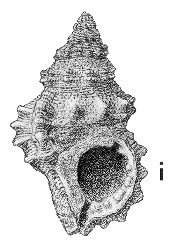
Revised descriptions of New Zealand Cenozoic Mollusca from Beu and Maxwell (1990)

 | Revised descriptions of New Zealand Cenozoic Mollusca from Beu and Maxwell (1990) | 
|
  (Pl. 24i): GS10365, D45/f8598, Long Beach, Clifden, Altonian (GNS) |
Beu & Maxwell (1990): Chapter 11; p. 223; pl. 24 i.
Synonymy: Triton minimum Tenison-Woods 1877, p. 107 (not Triton minimus Hutton, 1873); T. tortirostris Tate 1888, p. 123; T. crassicostatus Tate 1888, p. 125; T. oligostirus Tate 1888, p. 126; Cymatium octoserratum Finlay 1924b, p. 459; Austrotriton morgani Marwick 1931, p. 103 (not Triton morgani Ortmann, 1900); Austrosassia tortirostris; Cymatiella oligostira; C. octoserrata; Austrosassia morgani
Classification: Ranellidae: Cymatiinae
Description: Moderately large for subgenus (height 35-60 mm), spire moderately tall, about half total height, weakly stepped. Protoconch like that of S. maoria (Pl. 20o) and S. parkinsonia (Pl. 48f) but slightly smaller. Teleoconch whorls well inflated, angled at about middle on spire. Low varices at each 0.67 whorl down whole teleoconch. Sculpture of 5 major but very low, wide spiral cords forming 5 nodules on each varix, the upper 3 (or, on a few specimens, 4) cords bearing low, vertically compressed nodules where they cross the low, widely spaced axial costae; remainder of surface closely crowded with fine, low, finely gemmate spiral threads and very fine growth lines. Aperture large, subcircular; siphonal canal short to moderately long, weakly deflected, no fasciole. Inner lip with a parietal tubercle and a few ridges on base of columella; outer lip weakly flared, with 6-9 low, rounded nodules inside.
Comparison: Sassia tortirostris is easily distinguished from members of the S. maoria — S. parkinsonia species group by its larger size, its more inflated whorls, its more prominent sculpture of three peripheral rows of low nodules, and its more prominent varices. Its overall appearance is therefore as much like Cabestana as Sassia, but the fine surface sculpture is more like that of the S. maoria group than the prominent, wide spiral cords of Cabestana. It differs from species of the S. zealta group by its shorter spire and lower nodules.
Distribution: Otaian?; Altonian-Waiauan. Although not previously recorded as such from New Zealand, S. tortirostris is common in the Long Beach Shellbed, Clifden (Altonian), juvenile specimens from Target Gully, Oamaru (Altonian) were described by Finlay (1924b) under the name Cymatium octoserratum, and a severely abraded specimen from the "Tutamoe conglomerate" facies (Lillburnian) from the Gisborne district was named Austrotriton morgani by Marwick (1931) (but this is a secondary homonym of Sassia morgani (Ortmann, 1900), a Patagonian Oligocene member of the S. zealta group). Other specimens have been collected uncommonly from a wide range of Early to late Middle Miocene localities, in shallow-water, soft-bottom facies or shellbeds (Fouraye Siltstone (Altonian) to Nissen shellbeds (Waiauan), Clifden; Fallon's shellbed, Oamaru (Altonian); several North Auckland localities (Otaian, Altonian)). The type of T. tortirostris is from Mornington, Victoria (Balcombian, Middle Miocene), T. minimum and T. crassicostatus were described from Table Cape, Tasmania (i.e., Fossil Bluff, Longfordian, Early Miocene) and T. oligostirus from Adelaide Bore, South Australia (Aldingan, Late Eocene). All Australian specimens of S. tortirostris from Late Eocene localities are small (not more than 35 mm high) so S. oligostira might be recognisable as an ancestral Eocene form. We are not aware of specimens of S. tortirostris from the New Zealand Eocene, and a possible Duntroonian specimen is not well-enough preserved to be sure of the identification. Most New Zealand records are from Early to Middle Miocene rocks of North Auckland or Clifden, Southland, and it is rare in Oamaru district; S. tortirostris was evidently a relatively warm-water species. Other specimens with 2 dominant spiral cords around the centre of the whorls, common in Northland and in Long Beach Shellbed, Clifden (Altonian), agree in all characters with S. annectans (Tate, 1888), which can now be recorded fom New Zealand. Species of Sassia in Long Beach Shellbed are S. annectans, S. maoria, S. neozelanica (q.v.), S. tortirostris, and an extremely coarsely nodulose morphotype of S. zealta.
Cite this publication as: "A.G. Beu and J.I. Raine (2009). Revised
descriptions of New Zealand Cenozoic Mollusca from Beu and Maxwell (1990). GNS
Science miscellaneous series no. 27."
© GNS Science, 2009
ISBN
978-0-478-19705-1
ISSN 1177-2441
(Included with a PDF facsimile file
copy of New Zealand Geological Survey Paleontological Bulletin 58 in CD version
from: Publications Officer, GNS Science, P.O. Box 30368 Lower Hutt, New
Zealand)